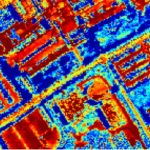Abstract: Signature-based detectors for hyperspectral target detection rely on knowing the specific target signature in advance. However, target signature are often difficult or impossible to obtain. Furthermore, common methods for obtaining target signatures, such as from laboratory measurements or manual… Read More
Tag: unmixing
Map-guided Hyperspectral Image Superpixel Segmentation Using Semi-supervised Partial Membership Latent Dirichlet Allocation
Abstract: Many superpixel segmentation algorithms which are suitable for the regular color images like images with three channels: red, green and blue (RGB images) have been developed in the literature. However, because of the high dimensionality of hyperspectral imagery, these… Read More
Semi-supervised Interactive Unmixing for Hyperspectral Image Analysis
Abstract: In the past several decades, hyperspectral imaging has drawn a lot of attention in the eld of remote sensing. Yet, due to low spatial resolutions of hyperspectral imagers, often the response from more than one surface material can be… Read More
Hyperspectral Unmixing with Endmember Variability Using Partial Membership Latent Dirichlet Allocation
Abstract: The application of Partial Membership Latent Dirichlet Allocation (PM-LDA) for hyperspectral endmember estimation and spectral unmixing is presented. PM-LDA provides a model for a hyperspectral image analysis that accounts for spectral variability and incorporates spatial information through the use… Read More
Hyperspectral Unmixing With Endmember Variability via Alternating Angle Minimization
Abstract: In hyperspectral unmixing applications, one typically assumes that a single spectrum exists for every endmember. In many scenarios, this is not the case, and one requires a set or a distribution of spectra to represent an endmember or class.… Read More
Alternating Angle Minimization Based Unmixing with Endmember Variability
Abstract: Several techniques exist for dealing with spectral variability in hyperspectral unmixing, such as multiple endmember spectral mixture analysis (MESMA) or compositional models. These algorithms are computationally very involved, and often cannot be executed on problems of reasonable size. In… Read More
Instance Influence Estimation for Hyperspectral Target Signature Characterization using Extended Functions of Multiple Instances
Abstract: The Extended Functions of Multiple Instances (eFUMI) algorithm is a generalization of Multiple Instance Learning (MIL). In eFUMI, only bag level (i.e. set level) labels are needed to estimate target signatures from mixed data. The training bags in eFUMI… Read More
Functions of Multiple Instances for Learning Target Signatures
Abstract: The functions of multiple instances (FUMI) approach for learning target and nontarget signatures is introduced. FUMI is a generalization of the multiple-instance learning (MIL) approach for supervised learning. FUMI differs significantly from standard MIL and supervised learning approaches because… Read More
Functions of multiple instances for sub-pixel target characterization in hyperspectral imagery
Abstract: In this paper, the Multi-target Extended Function of Multiple Instances (Multi-target eFUMI) method is developed and described. The method is capable of learning multiple target spectral signatures from weakly- and inaccurately-labeled hyperspectral imagery. Multi-target eFUMI is a generalization of… Read More
Spatial and spectral unmixing using the beta compositional model

Abstract: This paper introduces the beta compositional model (BCM) for hyperspectral unmixing and four algorithms for unmixing given the BCM. Hyperspectral unmixing estimates the proportion of each endmember at every pixel of a hyperspectral image. Under the BCM, each endmember… Read More